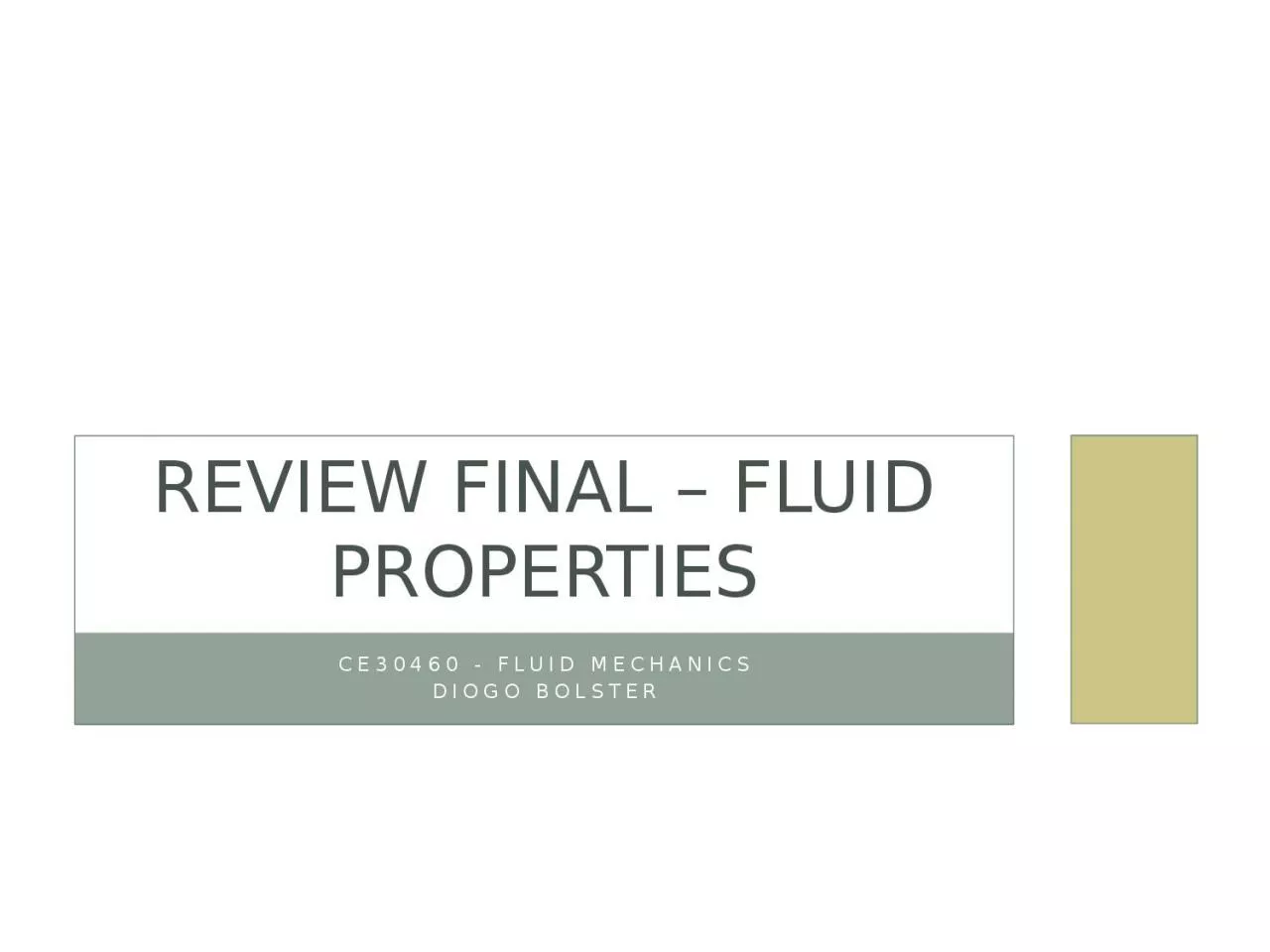

Diogo Bolster Review Final Fluid Properties Important Equations Chapter 1 Specific Weight g r g Ideal Gas Law p r RT Newtonian Fluid Shear Stress tm du dy Bulk Modulus ID: 1022706
Download Presentation The PPT/PDF document "CE30460 - Fluid Mechanics" is the property of its rightful owner. Permission is granted to download and print the materials on this web site for personal, non-commercial use only, and to display it on your personal computer provided you do not modify the materials and that you retain all copyright notices contained in the materials. By downloading content from our website, you accept the terms of this agreement.
1. CE30460 - Fluid MechanicsDiogo BolsterReview Final – Fluid Properties
2. Important Equations Chapter 1Specific Weight g=rgIdeal Gas Law p=rRTNewtonian Fluid Shear Stress t=m du/dyBulk Modulus Speed of Sound Capillary Rise in a Tube
3. Important Equations Chapter 2 (pressure gradient in a stationary fluid) (hydrostatic force on a plane surface) (Location of hydrostatic force on a plane)Fb=gVdisp (buoyant force)Manometer Equation
4. Useful Equations – Chapter 3Streamwise AccelerationBernoulli EquationFree JetFlow MeterSluice Gate
5. CH5 - Conservation of MassOften called ‘The Continuity Equation’What is velocity not uniform
6. CH5 - Conservation of Linear MomentumF=maSteady State
7. Momentum - Recipe Approach Draw Control VolumeIdentify all inlets and outletsIdentify all forces acting and their specific direction of action (break into x and y components)For each inlet and outlet calculate mass flow rate (rAv)For each inlet outlet identify velocity vector (v)Break velocity vector v into x and y componentsCombine last three steps to identify x and y components of momentum flux, i.e. v|xrAv and v|yrAvSubstitute into x and y momentum equations
8. CH5 - Moment of MomentumTorquePowerWork per Unit Mass
9. CH5 - Application (from textbook)U – velocity of head due to angular rotation (velocity of nozzle as measured relative to a fixed surface) - wRW – velocity of nozzle exit flow as viewed from the nozzle – Q/AV – fluid velocity as measured relative to a fixed control surface (typically what you need for formulas on previous slide)
10. CH5 - Conservation of EnergyFor steady, incompressible flow with shaft work
11. CH6 - Vorticity (Rotation)Counterclockwise rotation is positive (z component is component out of the page). Others, in x-y also existvorticity (zero => irrotational)Related, rate of shearing strain
12. CH6 - Forms of Continuity EquationGeneral FormSteadyIncompressible
13. CH6 - Cylindrical Polar CoordinatesGeneral FormSteadyIncompressible
14. CH6 - StreamfunctionFor incompressible, plane two dimensional flow we can define a streamfunction psi, such thatQuantifies the flow rate between two streamlines (lines of constant psi)Cylindrical:
15. The Navier Stokes Equations
16. In Cylindrical Coordinates
17. Our assumptions2d (x-y or r-z or r-q)IncompressibleSteady State (d/dt=0)Fully Developed (d/dx=0 or d/dz=0 – except pressure)With these we are typically left with a 2nd order ordinary differential equation that we can readily solve.We then must apply boundary conditions for unknown constantsNo flow (velocity normal to a boundary is zero)No slip (fluid velocity tangential to a boundary is the same as the velocity of the boundary)
18. CH7 – Dimensional AnalysisBuckingham Pi TheoremI an equation involving k variables is dimensionally homogeneous, it can be reduced to a relationship among k-r independent dimensionless products where r is the minimum number of reference dimensions required to describe the variablesMathematically can be reduced to
19. Determination of Pi termsList all variables that are involved in the problemExpress each on in terms of primary dimensions (MLTq)Determine required number of Pi terms (each independent) – i.e. k-rSelect a number of repeating variables (equal to number of dimensions)Form pi terms by multiplying one of the nonrepeating variables by the product of repeating variablesRepeat last step for all nonrepeating variablesCheck that all resulting Pi terms are dimensionlessExpress in final form
20. Data Problems with One Pi Term :If only one term exists then according to the Pi Theorem we can say: P1=CFor two terms P1=f(P2) P1=f(P2)Means when you have data you should plot P1 against P2 to deduce relationships or at least make best fits that can be used predicatively.
21. Types of SimilarityGeometric (ratio of length scales the same)Kinematic (velocity structures are the same)Dynamic (ratio forces the same)The best situation is: Get all dimensionless variables (Pi groups) the same between model and prototype. Then all similarities are preserved…..If N-1 dimensionless groups between model and prototype are the same then the last one must be also.
22. CH8 - PipeflowRe<2000Re>4000Re=UDr/m
23. Fully Developed FlowEntrance length:
24. Energy EquationRecall Energy EquationTherefore we can say that (part of) the loss in a pipe is
25. Moody Diagram (Friction Factor)For non-laminar flow approximately true thatFor laminar
26. Pipe Flow MeasurementC is a constant that depends on geometry